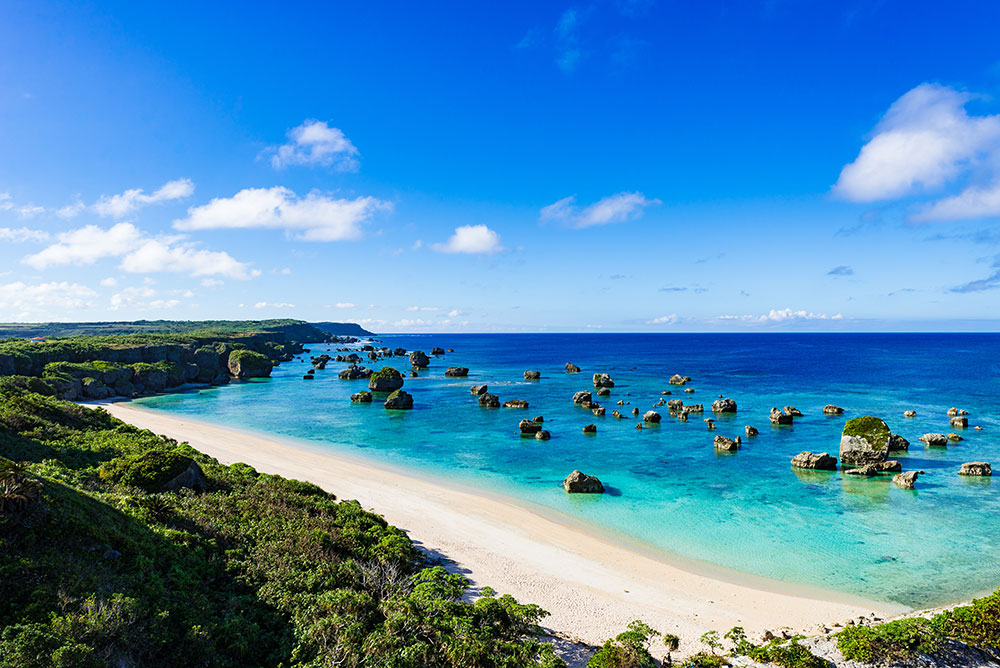

RYUKYU ISLANDS – ARCHIPELAGO WITH OKINAWA
Ryukyu arc
Ryukyu is a group of about 200 islands between Taiwan and Kyushu, forming a 1,200-metre chain separating the East China Sea from the Philippine Sea. Situated in the Okinawa prefecture, it is – next to Amami, Miyako and Yaeyama – one of the four main islands of the archipelago. The total surface area of the Ryukyu volcanic islands is over 4,000 km2.
Ryukyu Kingdom
The paradise archipelago has only been a part of the Japanese administrative network since mid-19th century. Before that, from around the 12th century, Ryukyu was an autonomous, more or less independent country. In the 14th century, the Ryukyu Kingdom recognised the suzerainty of China, thus initiating trade with one of the world’s largest superpowers of that time. Over the next 500 years, the islands were the recipients not only of precious goods but also of Chinese culture and customs, the influence of which can be seen in the ethnic landscape of Ryukyu to this day. Japan was also interested in the islands, and at the beginning of the 16th century it managed to seize control of Ryukyu. This commenced the period of the so called ‘dual dependency,’ where the Kingdom functioned as the vassal of both China and Japan.
Japanese Ryukyu Islands
When after the downfall of shogunate Japan started to open up to the world, it turned out that Ryukyu were in the way of beneficial trade and economic exchange with countries of the Occident. Western ships would stop on the picturesque islands whose citizens, even though friendly and polite, refused any official contacts. To expand its network of international connections, Japan increased its efforts to annex the borderline archipelago. Annexed by the Japanese emperor, the Ryukyu Kingdom ultimately ceased to be in 1879.
Turbulent history
Even after they were incorporated into Japan, the situation of the islands did not stabilise. World War II brought them not only 2,000 of bloody casualties but also another change of control. During the American invasion, Okinawa became a living shield for the Japanese empire, with premeditation exposed to enemy fire. The lost battle commenced American occupation lasting for almost 30 years. So no wonder that American popculture has influenced today’s Ryukyuan culture to a greater extent than it did in the other regions of Japan. This is where the first coca-cola bottles and rock & roll sounds arrived. It was not until 1972 that Japan recovered Okinawa but American army still has its military bases on the island.
Culture of the Ryukyu islands
The complicated history of the archipelago explains why the culture of Ryukyu differs from native Japanese culture. Due to international influence and years of autonomy, the inhabitants developed a separate ethnic identity, whether in terms of customs, temperament and language. Even though formally, the language or – to be more precise – languages spoken by the inhabitants of Ryukyu are considered dialects of Japanese, they are increasingly often classified as a separate group of Ryukyan languages. Instead of sake, Ryukyuans drink awamori – a traditional rice alcohol made through distillation (and not fermentation – as it is the case for sake). The bottles of the Okinawa alcohol sometimes contain a Japanese snake habu, which is why one variety of awamori is also known as ‘snake wince.’ The characteristic dishes of the region include fried go-ya-champuru (made of bitter melon, egg, tofu and pork), as well as… taco rice – an Asian version of American tacos, served with rice. Unlike the cold and reserved Japanese, the islanders are said to be cheerful and kind.
Tourist attractions of the Ryukyu islands
Due to their unique climate and natural beauty, the islands and islets of the Ryukyu arc are a true paradise for all kinds of tourists: nature lovers, lazy sunbathers, cultural travellers, explorers of the exotic world of the Orient. Okinawa is the only region in Japan with warm subtropical climate, with the average yearly temperature of about 24°C. Wild white beaches, paradise bays, transparent turquoise water… You can’t ask for more. Diving enthusiasts may enjoy the colourful coral reefs, while those who love of urban strolls – mementos of the former greatness of the Ryukyu Kingdom.
Okinawa – what to see and when to go
The subtropical climate of Okinawa makes the sandy beaches of Karama, Miyako or Yaeyama a perfect place to visit all year long. However, July and August are the rainy season, so even though the temperature is excellent for bathing, the holiday may be accompanied by downpours. Leisure in the bosom of nature can be complemented with sightseeing of Okinawa’s major attractions, with the Shuri castle in the Ryukyu capital and various monuments commemorating the bloody history of the area. If you are not convinced by the amazing cultural uniqueness and special history of the Ryukyu arc and you are still wondering if Okinawa is worth visiting, take a look at the picturesque landscapes of the virgin areas and submit to their incredible magic.























